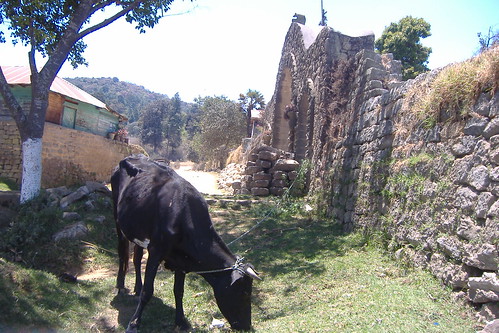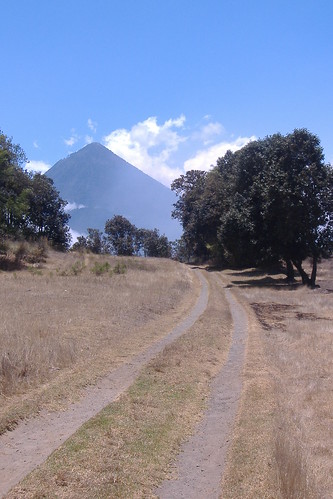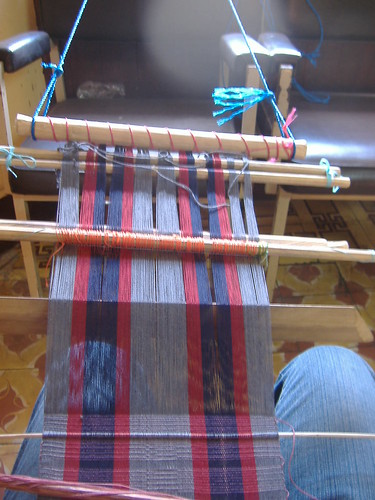It had been a joke for us for some time now. Every weekend that we’ve stayed in town, except of course for that weekend we took the exhaustive and debilitating hike up to Laguna Chicabal—if you speak Mam or think that k’s and apostrophes make words look awesome you could call it Chikab’al I guess—we’ve said the same thing. “Well, we could see if a movie’s playing at la Pradera, maybe buy some non-processed cheese (seriously, our cheese choices in town are queso fresco, queso duro, or the frighteningly plastic queso amarillo) at HiperPaiz, or maybe we could go to los Vahos.”
El vaho is el vapor, but less the idea of something steamy as something with fumes and odors. Los Vahos is a sauna, described by my ever-so-pithy guidebook as “rough and ready”, which capitalizes on the geothermal steam that seeps out of vents on a mountainside rather than on hot embers doused with water (various Maya groups bathe in smaller saunas like this, calling them either chuj or tuj depending on the peculiarities of their language) to produce the hot, humid air.
This Saturday our quickly vanishing time here finally built enough of a fire under us to make us set out early to follow my book’s ambiguous directions to the site, of course after stopping for a desayuno típico (I could write two hundred words on how this place has made me reconsider my previous opinion on all-day breakfast places)to give us the strength we’d need for the climb. One thing we learned from the Chicabal ascent was the disadvantages of hiking while hungry.
Walking south along Trece Avenida we passed the crappy Despensa Familiar grocery that frequently plays loud high-energy reggaeton for its clientele and mechanics’ garages each with their own dog lying languidly in the entrance. In no time the flatland portion of our trip ended and we started climbing up the mountain that looms over the south of town with the CRISTO VIENE sign of Santuario Monte Sinai. We ran in to one of the few mutual acquaintances that Ilene and I have in this city—how many people are interested in both organic gardening and backstrap loom weaving?—and chatted with her for a while. In true Marin county fashion she advised us not to get “sketched out” by los Vahos, since it “looks and smells like an Indian toilet”. Luckily for us, we have no idea of hygiene standards of the subcontinent and we started walking up the switchbacking road up the hill.
The bubble of prosperity and comfort that covers most of the city center quickly faded away and we were hailed on the road by a strange man who felt it important to repeatedly tell us “No se preocupen”, a sure sign that we should preocuparnos. I listened to what he had to say, paying him just enough attention to keep him from getting angry with us while Ilene pointedly stood far away and admired the view. After telling me how he used to live outside Los Angeles and how some dudes threw him off an exit ramp and how all the Super Chivos know who he is, he got bored and moved on, and we stayed gazing on the city below trying to pick out the places we know from the bird’s-eye view we had.

You can easily see the newly-repainted white domes of the cathedral fronting the Parque Centroamérica, the area obscured by the Casa de Cultura and a clump of trees. The yellow building to the left is the Despensa Familiar which I mentioned. Running down the middle of the photograph is Doce Avenida which we walk down to get to the school where we work, located on the block just south of the Esso gas station. A Volkswagon’s parked in front.
Moving on once we figured that the strange man had moved on, we went beyond where the irregular cobblestones of the street gave way to the worndown grass of a path. Already we were outside of Xela, though we wouldn’t know exactly where we’d be for some time. The land on either side of us was grassy hills and forested mountainside, broken by fallow fields and their stone enclosures. This scene reminded me of what my mind paints the landscape of northern California or Normandy to be, though with volcanoes in the background.


Our directions told us to follow the road past a dairy and a school. Well, as you can see, we found the dairy, and following the advice Naomi had given us that we should keep moving uphill we took the road straight past the dairy, leading us on a long walk through the mountain. It was the wrong way, and though the main path we were on looked as though it had been tread by trucks or fourwheelers in the recent past, all of the branches quickly became half-overgrown footpaths leading straight up the mountain.
This was the monte. We saw no one for a long time. We heard no one. All the noise that was around was the cracking of the dry leaves under our feet, the occasional rustling of a critter quickly getting out of our way, and the constant whoosh of the air through the tall pine trees that dotted the mountainside. We kept going uphill, until the path started to head downhill. Then we noticed that we were on the other side of the mountain, our view now showing the valleys and plains around what Ilene and I believed was Almolonga, the first town we visited during our stay here.
Since the path was now dropping considerably, we retraced our steps. Ilene expressed her amazement over the sauna’s owner’s failure to adequately mark the path to the establishment. At this point, you might think that we’d’ve been quite annoyed with not finding the vahos, but we felt so rewarded by the views that we actually didn’t care if we just walked back down into the city center sweaty and unsteamed. I even mentioned aloud that we should go on more hikes and such when we return to the States.


Once we got back to the dairy, we noticed the other branch of the path heading across fields and looking rather obviously like the correct path. Hindsight being twenty-twenty and everything.
The walk across the fields was pleasant, watching cows rest in the surprisingly cool breeze and chickens squawk and fuss about. Then Ilene stopped to take a picture of some dogs playing by a house and an opportunistic young boy ran out to meet us from behind a house and greeted us with “¿Un quetzal?”.
The rest of the path went by quickly with our knowledge that we were definitely on the right path and the knowledge that we were in a place that was populated enough to have a name, Cantón Xetuj. Ilene said that she believed more gringos see this part of the city’s periphery than quetzaltecos. She’s right I bet.
Eucalyptus trees guarded the road leading up to los vahos. Two dogs also guarded the road. At first, Ilene was wary of the dogs, since they barked as we approached, and since she had been lunged at rather surprisingly by the dog accompanying a group of teenagers heading downhill with loads of firewood. These dogs were actually among the most inquisitive and playful and just the happiest dogs I’ve seen in a long time. They quickly upgraded themselves in our book from mean dogs to friendly chuchos. They even stood guard while I used the bathroom at the sauna.
Well, we had arrived. We paid for our hour of sauna use to the proprietor, a man in a baseball cap and teeshirt who infuriatingly spoke to us in pidgin Spanish the entire time. We went down to the rooms below to change into our swimsuits and enter the very hot sauna.

Neither one of us had been in a sauna before, and we enjoyed the experience. I didn’t enjoy hitting my head on the low concrete lintel of the doorway, and Ilene didn’t enjoy seeing a pair of roaches, but all in all, we’re glad we got to experience it. The sauna wasn’t just plain steam either as the owner had placed eucalyptus leaves, perhaps leaves from the trees we had passed on our way up, over the vents, making the sauna feel like a cross between a hot shower ad vaporub. Our lungs which have been plagued by the smog and dust of Xela felt cleared out and simply wonderful. Naomi said that she found the vahos cleansing, and we had chalked her choice of words up to her being more than a bit of a hippie, but I think she spoke accurately.
Our hour up, the proprietor came to the door tapping his watch and saying “Tiempo, tiempo”. No Spanish speaker would use that word to say that our time was up, they’d instead tap their watches and say “la hora”. Then as we finished getting dressed, reluctantly putting our dusty socks over our clean feet, he stood in the doorway being creepy.
The chuchos came along with us as we walked back down the road, the air feeling comparatively cold and the breeze drying us off. Then they stood at attention in the road and then happily ran after the SUV driven by who we can only assume was their owner that came up the hill.

Once back in town, our tired legs demanded to be relieved of our weight, but first we stopped to buy some wine for our attempt at making charoset, and some beer for good measure. The wine was cheap and suitably oversweetened, and by the clerk’s inability to do math, we got four bottles of Brahva for the price of one. We also followed up on our boss Marilu’s suggestion that we pick up some paches from the Hotel Americano. Given the name of the place, we’d never have gone their by ourselves, and befitting their name, they actually had Budweiser on the menu, making it the only place that I’ve seen an American beer offered in Guatemala. They don’t even have a reliable selection of Mexican beers, even in Tilapa which is a handful of miles from the border.
The paches were big tamales made with rice to which raisins, olives, and what we think are dates added to the mix. And there was also a sizeable piece of chicken which had been steamed in the corn-leaf wrapped tamal. We were so surprised that this only cost us Q7.50 each. Between this and the cashier’s failing to note that four beers should cost much more than Q7.75, the Gods of Cheap Food were smiling upon us. Too bad we probably won’t have any more Saturday nights in this town, because this could easily have become a tradition of ours.
Then we went home and made some charoset for dessert and listened to some Beatles while our Lutheran landlords sat in their small room below us and sang hymns. What a day.
Okay, this is Ilene again. I would just like to add that
1. the cockroaches were huge!
2. I have finished weaving my scarf:

It is pretty.
3.There is a fruit here called the zapote. The inside is orange and doesn’t look unlike pumpkin.
4.The week’s work is pretty much over since the Holy Week is upon us. We’re headed to the little town of Salcajá tomorrow for a day trip.
5.Wednesday we’re headed north of the border to Mexico (crazy that it’s north and not south, huh? I’ll say.)—staying the first night in Comitán and then onward to San Cristóbal de las Casas, all in Chiapas. Ay de mí.
6.Happy Passover… and April!
3 comments:
Happy Passover & April to you too. Have a great trip.
El vaho is el vapor.
The word Baho, in Las Islas means (something) to smell bad. Must be connected in some weird way to Spanish like some other words we have here which have been bastardized in one way or another.
Well written article.
Post a Comment